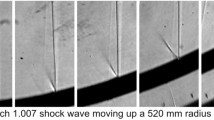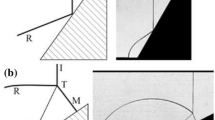Abstract
It has been shown that when a plane shock wave is reflected off a surface consisting of a 75-mm radius circular arc followed by a plane section inclined at 45°, it takes some time for the interaction to reach a pseudosteady reflection configuration. The current study extends this work at a constant Mach number of 1.346, with three compound walls, consisting of leading circular sections of 30, 50 and 75 mm radius, joined to a plane wall section. Testing was done at various wall angles for each of the test pieces. The reflected wave angle was measured and was found to increase along the plane wall section until it reached an asymptotic value, at which time pseudosteady flow was established. The asymptotic values are consistent with reflection off plane wedges and are independent of the leading radius. For lower wall angles which lead to Mach reflection the length required to reach pseudosteady flow increases as the wall angle increases to the pseudosteady transition angle. The reverse occurs when the final pseudosteady reflection is regular, in that as the wall angle increases the distance travelled to reach pseudosteady flow conditions decreases. Additional tests were conducted on a specimen consisting of a plane section at 60° wall angle with 30-mm radius circular arc sections at either end. It is demonstrated how the information from the two slope changes influences the shape of the reflected shock. The trajectories of two perturbations on the reflected shock arising from the joints between the circular sections and the plane wall show that the reflected wave remains linear between these two points, as it received no knowledge from either circular section until the perturbations from the upper and lower joints cross.
Similar content being viewed by others
References
Ben-Dor G.: Shock Wave Reflection Phenomena. Springer, Berlin (2007)
Hornung H.G., Oertel H., Sandeman R.J.: Transition to Mach reflexion of shock waves in steady and pseudosteady flow with and without relaxation. J. Fluid Mech. 90, 541–560 (1979)
Kirkup L.: Experimental Methods. John Wiley and Sons Australia, Ltd, Milton (1994)
Skews B.W., Kleine H.: Flow diagnostics using weak perturbations. Exp. Fluids 46, 65–76 (2009)
Skews B.W., Kleine H.: Shock wave interaction with convex circular cylindrical surfaces. J. Fluid Mech. 654, 195–205 (2010)
Smith, L.G.: Photographic investigation of the reflection of plane shocks in air. Technical report, Off. Sci. Res. Dev. OSRD Rep 6271 (1945)
Author information
Authors and Affiliations
Corresponding author
Additional information
Communicated by O. Igra.
Rights and permissions
About this article
Cite this article
Skews, B., Blitterswijk, A. Shock wave reflection off coupled surfaces. Shock Waves 21, 491–498 (2011). https://doi.org/10.1007/s00193-011-0334-y
Received:
Revised:
Accepted:
Published:
Issue Date:
DOI: https://doi.org/10.1007/s00193-011-0334-y




